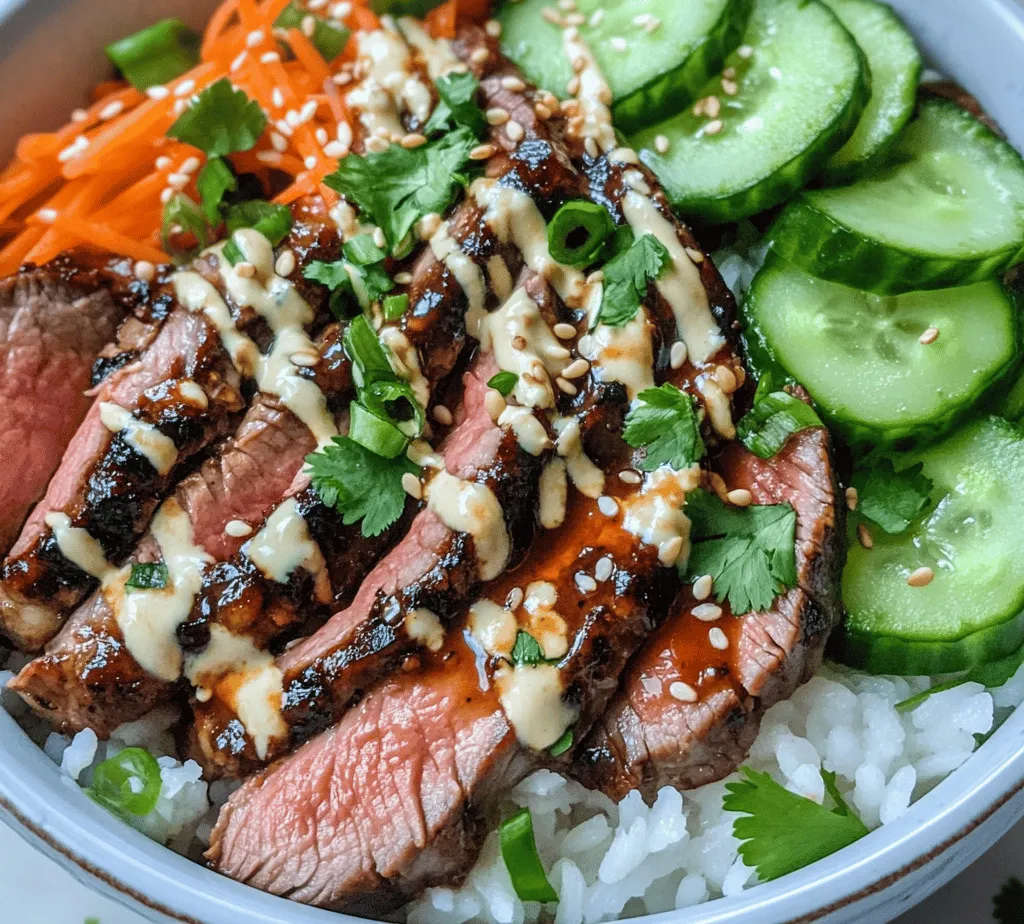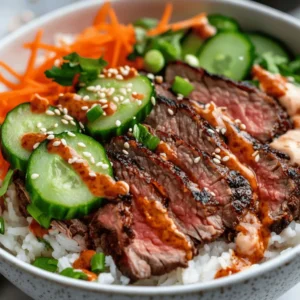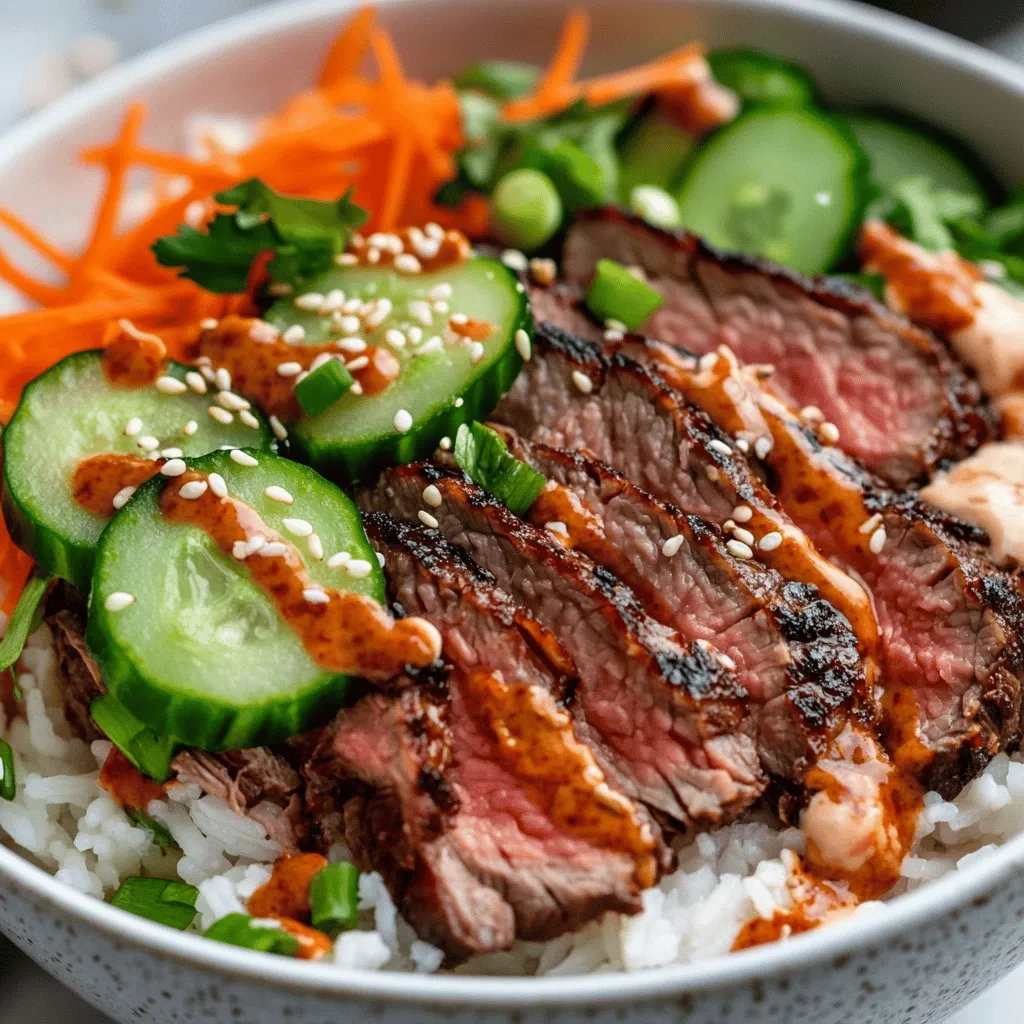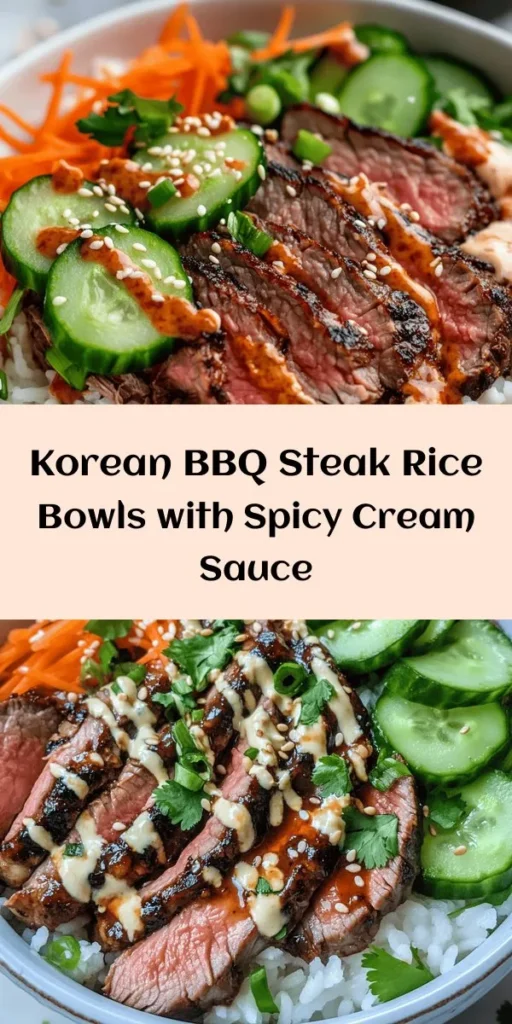Introduction
Korean BBQ cuisine has surged in popularity worldwide, captivating food enthusiasts with its rich flavors, vibrant presentation, and the communal experience of grilling. Originating from Korea, this style of cooking emphasizes the use of marinated meats, grilled to perfection, and served with a variety of side dishes known as banchan. Among the many dishes inspired by this culinary tradition, Korean BBQ Steak Rice Bowls with Spicy Cream Sauce stand out for their delightful fusion of textures and tastes.
This recipe marries tender, marinated steak with a heavenly spicy cream sauce, all served over a bed of fluffy jasmine rice and topped with fresh vegetables. The combination of savory, sweet, and spicy flavors creates a well-rounded meal that is not only satisfying but incredibly enjoyable to prepare. This dish is perfect for home cooks looking for a quick yet impressive dinner option, allowing you to bring the vibrant tastes of Korean BBQ into your kitchen.
Understanding the Ingredients
To truly appreciate the depth of flavor in Korean BBQ Steak Rice Bowls, it’s essential to understand the key ingredients that contribute to this dish. Let’s dive into the primary components, starting with the marinade that transforms the steak into a flavor-packed star of the meal.
Key Ingredients in the Marinade
The marinade is the heart of this recipe, and it plays a crucial role in infusing the steak with rich, Korean flavors. The core ingredients typically include:
– Soy Sauce: This is the backbone of the marinade, providing a salty umami flavor that enhances the meat’s natural taste. The soy sauce also helps tenderize the steak, making it juicy and flavorful.
– Brown Sugar: Not only does brown sugar add a touch of sweetness, but it also helps to caramelize the meat when grilled, creating a beautiful crust that adds texture to the dish.
– Sesame Oil: A staple in Korean cooking, sesame oil brings a nutty aroma and flavor that complements the other ingredients. Its richness adds depth to the marinade, making the dish more complex and satisfying.
– Garlic and Ginger: These aromatic ingredients are essential in Korean cuisine. Fresh garlic adds a pungent kick, while ginger lends a warming spice. Together, they elevate the overall flavor profile of the marinade.
– Red Pepper Flakes: For those who enjoy a bit of heat, red pepper flakes introduce a mild spiciness that enhances the dish without overpowering it. Adjust the amount according to your heat preference.
– Rice Vinegar: This ingredient adds a tangy note that balances the sweetness from the brown sugar, creating a well-rounded marinade.
Breakdown of the Rice Bowl Components
While the marinated steak is the star of the show, the other components of the rice bowl are just as important for achieving a harmonious dish. Here’s a closer look at the essential elements:
– Jasmine Rice: A staple in Korean and many Asian cuisines, jasmine rice is known for its slightly floral aroma and sticky texture. It serves as the perfect base for soaking up the flavors of the marinade and sauce.
– Fresh Vegetables: To add crunch and nutrition, we’ll include fresh vegetables like cucumber, carrots, and green onions. These ingredients not only contribute to the visual appeal of the dish but also add layers of flavor and texture.
– Cilantro and Sesame Seeds: As garnishes, cilantro brings a fresh herbal note, while sesame seeds add a nutty crunch. Together, they enhance the overall presentation and elevate the dish’s flavor profile.
Insight into the Spicy Cream Sauce
The spicy cream sauce is a game-changer for this recipe, offering a delicious contrast to the savory marinated steak. It combines the heat of Korean chili paste with the creaminess of mayonnaise, resulting in a sauce that is both flavorful and versatile.
– Gochujang: This fermented Korean chili paste is the star ingredient in the spicy cream sauce. Its complex flavor combines heat, sweetness, and umami, making it a quintessential element in Korean cooking.
– Mayonnaise: The creaminess of mayonnaise provides a rich, smooth texture that balances the bold flavors of gochujang. This combination creates a sauce that coats the steak beautifully and adds an exciting flavor punch.
Together, these ingredients create a vibrant and delicious meal that celebrates the essence of Korean BBQ while offering a unique twist.
Marinating the Steak
Marination is a crucial step in preparing Korean BBQ Steak Rice Bowls, as it enhances the flavor of the meat and ensures a tender texture. Here’s how to achieve the perfect marinade and elevate your steak:
Step-by-Step Process of Creating the Marinade
1. Mix the Ingredients: In a medium-sized mixing bowl, combine the soy sauce, brown sugar, sesame oil, minced garlic, grated ginger, red pepper flakes, and rice vinegar. Whisk them together until the sugar is dissolved and the mixture is well-blended.
2. Prepare the Steak: Choose flank steak for its ideal balance of tenderness and flavor. Trim any excess fat and slice the steak against the grain into thin strips. This will help the marinade penetrate the meat more effectively and ensure tenderness after cooking.
3. Marinate the Steak: Place the sliced steak into a resealable plastic bag or a shallow dish. Pour the marinade over the steak, ensuring all pieces are evenly coated. Seal the bag or cover the dish tightly, and refrigerate for at least 30 minutes. For optimal flavor absorption, marinate for 2 to 4 hours if time permits.
Tips on Achieving the Perfect Marinade Consistency
For a successful marinade, consistency is key. Here are some tips to ensure your marinade turns out perfectly:
– Balance: Aim for a balance between wet and dry ingredients. Too much liquid can make the steak soggy, while not enough can result in uneven flavor. Adjust the proportions of soy sauce and brown sugar according to your taste preference.
– Fresh Ingredients: Use fresh garlic and ginger for the best flavor. Pre-packaged versions may not provide the same intensity.
– Taste Test: Don’t hesitate to taste the marinade before adding the steak. Adjust the seasoning as needed by adding more soy sauce, sugar, or spice to suit your palate.
Recommended Marination Time for Optimal Flavor Absorption
While a quick 30-minute marination can yield tasty results, longer marination times enhance the flavor significantly. Aim for at least 2 hours, or overnight if your schedule allows. This extended time allows the flavors to penetrate deeply into the meat, resulting in a more flavorful and tender dish.
Discussion on the Choice of Flank Steak and Its Cooking Properties
Flank steak is the preferred choice for this recipe due to its bold flavor and relatively lean profile. It has a pronounced beefy taste that stands up well to the marinade. Additionally, flank steak cooks quickly, making it ideal for a weeknight meal. When cooked correctly, it remains juicy and tender, especially when sliced against the grain.
In summary, marinating your steak is not just about flavor; it’s about creating a memorable dish that showcases the essence of Korean BBQ. With the right marinade and cooking techniques, you’ll be well on your way to crafting a delicious meal that will impress your family and friends alike.
Preparing the Spicy Cream Sauce
As the steak marinates, it’s the perfect time to prepare the spicy cream sauce that will elevate your rice bowls. Here’s how to create this delectable addition, step by step.
Detailed Breakdown of the Sauce Ingredients and Their Roles
1. Gochujang: Start with a couple of tablespoons of gochujang as the base for your sauce. This ingredient is what gives the sauce its signature heat and depth of flavor. Adjust the amount based on your spice tolerance.
2. Mayonnaise: Combine the gochujang with mayonnaise to create a creamy consistency. The mayonnaise helps mellow out the heat from the gochujang while adding richness to the sauce.
3. Additional Flavor Enhancers: Consider adding a splash of lime juice or a teaspoon of honey to balance the flavors. The acidity from the lime juice will brighten the sauce, while honey can add a touch of sweetness that complements the spiciness.
4. Mixing It All Together: In a small bowl, whisk together the gochujang, mayonnaise, and any additional ingredients until smooth and well-combined. Taste the sauce and adjust seasonings as needed.
5. Storage: If you prepare the sauce in advance, store it in an airtight container in the refrigerator for up to a week. The flavors will meld and deepen as it sits, making it even more delicious for your rice bowls.
By following these steps and understanding the role of each ingredient, you’ll create a spicy cream sauce that perfectly complements the marinated steak and adds an exciting zing to your Korean BBQ Steak Rice Bowls.
In the next part of this article, we will cover the cooking process for the steak, assembling the rice bowls, and serving suggestions that will take your dish to the next level. Stay tuned for more delicious details!

Balancing Flavors in Korean BBQ Steak Rice Bowls
One of the hallmarks of Korean cuisine is its vibrant balance of flavors, which often includes spicy, sweet, and tangy elements. This harmony is essential when preparing your Korean BBQ steak rice bowls with spicy cream sauce. The spicy cream sauce is designed to elevate the dish with its kick, while the sweetness balances the heat and the tang adds brightness. Adjusting the spice levels to suit your personal preference is crucial; you can easily modify the amount of gochujang (Korean chili paste) in the sauce or add a hint of honey or sugar if you prefer a sweeter profile.
Step-by-Step Instructions for Mixing the Sauce
1. Gather Your Ingredients: Start with your base ingredients, which typically include mayonnaise, gochujang, soy sauce, sesame oil, and a splash of rice vinegar.
2. Mix the Base: In a medium-sized bowl, combine 1 cup of mayonnaise with 2 tablespoons of gochujang. Adjust the amount of gochujang based on your heat preference—start with less if you’re sensitive to spice.
3. Add Flavor Enhancers: Stir in 1 tablespoon of soy sauce for umami, 1 teaspoon of sesame oil for nuttiness, and 1 tablespoon of rice vinegar for acidity.
4. Whisk Until Smooth: Use a whisk or a fork to blend all the ingredients well until the sauce is creamy and uniform in color. Taste the sauce and adjust seasoning as needed, adding more gochujang for heat or honey for sweetness.
Alternative Sauces or Modifications
If you’re looking to customize the sauce for dietary preferences, consider using Greek yogurt instead of mayonnaise for a lighter version. You can also create a vegan alternative by substituting the mayonnaise with an egg-free version or silken tofu blended until smooth. For a different flavor profile, try adding minced garlic or ginger, or even a splash of lime juice for a zesty twist.
Cooking the Steak
The star of your rice bowl is undoubtedly the steak. Here’s how to achieve a perfectly cooked piece of meat:
1. Choosing the Right Cut: Flank steak or sirloin is recommended for optimal flavor and tenderness.
2. Marinate the Steak: For at least 30 minutes (or overnight for deeper flavor), marinate your steak in a mixture of soy sauce, sesame oil, minced garlic, and ginger.
3. Preheat Your Pan or Grill: Aim for high heat. If using a cast-iron skillet or grill, allow it to heat up for several minutes until very hot.
Tips for Achieving the Best Sear
– Pat Dry: Ensure your steak is dry before cooking; moisture can prevent a good sear.
– Use Oil Sparingly: A light coating of oil on the steak or in the pan is sufficient to prevent sticking.
Recommended Cooking Times
– Rare: Cook for about 2-3 minutes per side.
– Medium Rare: Aim for 3-4 minutes per side.
– Medium: Cook for 4-5 minutes per side.
– Medium Well: Cook for 5-6 minutes per side.
– Well Done: Cook for 6-7 minutes per side.
Importance of Resting the Steak
Once your steak reaches the desired doneness, remove it from the heat and let it rest for at least 5-10 minutes. This step is essential as it allows the juices to redistribute throughout the meat, ensuring a moist and flavorful bite.
Techniques for Slicing Steak Against the Grain
To maximize tenderness, slice the steak against the grain. Identify the direction of the muscle fibers and cut across them, not parallel. This technique shortens the fibers, making each bite easier to chew.
Assembling the Rice Bowls
Now that your steak is cooked and resting, it’s time to assemble those beautiful rice bowls:
1. Prepare Your Base: Start with a generous scoop of cooked rice (white, brown, or cauliflower rice for a low-carb option).
2. Layering Ingredients: Begin by placing your sliced steak on top of the rice, followed by your spicy cream sauce drizzled generously over the meat.
3. Add Vegetables: Incorporate a variety of colorful vegetables. Consider using shredded carrots, sliced cucumbers, or blanched broccoli for a pop of color and added crunch.
Suggestions for Variations in Bowl Assembly
Feel free to experiment with different protein options such as chicken, tofu, or shrimp. Adding kimchi or pickled vegetables can also enhance the flavor and provide a delightful contrast to the rich cream sauce.
Visual Presentation Tips
The visual appeal of your rice bowls can elevate the dining experience. Use vibrant ingredients and arrange them artfully within the bowl. Consider using a shallow, wide bowl that allows the colors and textures to stand out. A sprinkle of sesame seeds and fresh herbs, like cilantro or green onions, can provide the finishing touch.
Serving Suggestions
To complement your Korean BBQ steak rice bowls, consider serving them with side dishes such as:
– Korean Pickled Radish: A crunchy, tangy side that cuts through the richness of the steak.
– Kimchi: Fermented vegetables that add a spicy and sour kick.
– Steamed Edamame: Lightly salted for a simple yet satisfying addition.
Beverage Pairings
For drinks, a cold beer or a refreshing Korean rice wine (makgeolli) pairs beautifully with the meal. If you prefer non-alcoholic options, try iced green tea or a fruit-infused sparkling water.
Storing Leftovers and Reheating
If you have leftovers, store your rice and steak separately to maintain texture. Place in airtight containers and refrigerate. The rice can be reheated in the microwave with a splash of water for moisture, while the steak can be warmed gently in a skillet over low heat to prevent drying out.
Nutritional Information
These rice bowls are not only delicious but also packed with nutrients.
Overview of Nutritional Benefits
– Protein: The steak is an excellent source of protein, essential for muscle repair and overall health.
– Carbohydrates: The rice provides a good source of complex carbohydrates for energy.
– Vegetables: Adding a variety of vegetables enhances the fiber content, vitamins, and minerals in your meal.
Healthy Modifications
To make the dish healthier without sacrificing flavor, consider:
– Using Brown Rice: For added fiber.
– Incorporating More Vegetables: Aim for a colorful variety to maximize nutrients.
– Reducing Sauce: Use less mayonnaise in the spicy cream sauce or opt for a yogurt-based sauce for fewer calories.
Conclusion
In summary, these Korean BBQ steak rice bowls with spicy cream sauce are not just a meal; they are an experience that brings the vibrant flavors of Korean cuisine to your kitchen. With straightforward preparation steps, you can create a dish that impresses both visually and in taste. This recipe is perfect for weeknight dinners, meal prep, or entertaining guests.
Embrace the joy of home cooking, experiment with flavors, and share this delightful dish with loved ones. So gather your ingredients, fire up the grill or stovetop, and enjoy the satisfying process of creating a memorable meal. Exploring Korean cuisine through this flavorful dish is just the beginning; let it inspire you to try more recipes and discover the richness of this culinary tradition.



